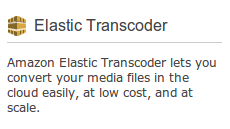Amazon Elastic Transcoder
Hello! 
Amazon Web Services provided their users with the new Elastic Transcoder video processing service. As you understand, the main point is transcoding video.
The service is a date of the pipeline. We give it information from where to get the video, where and in what format to put it and that's it. I have already tried and want to show you, tell you what and how.
First we need 2 S3 baket: one as outgoing, the other as receiving:
Next, in the Elastic Transecoder console, create a new pipeline:

')
Enter the names of the buckets and call pipeline:

Next, we will have a standard console:

In the menu on the left we see more items of tasks and presets. It is very interesting to look at the presets:

As you can see, the service gives us templates for regular formats, and for popular mobile devices. You can also create a template yourself and enter all the parameters of the video.
So, we have a certain video uploaded to the et_test_source batch , we need to transcode it. Create a task:

Next, the task appears in the Jobs tab with the status Processing .
After the task has completed, the desired file will appear in the et_test_dest bakery:

The file format corresponds to the preset used:
Cost Elastic Transecode is paid by the minute.
* Prices are for the US-EAST-1 region.
This is how Amazon Web Services created another new service that, in my opinion, will be very interesting to our customers. I'm curious if you calculated the cost of a minute of video using solutions on servers? Is this service interesting for you?

Amazon Web Services provided their users with the new Elastic Transcoder video processing service. As you understand, the main point is transcoding video.
The service is a date of the pipeline. We give it information from where to get the video, where and in what format to put it and that's it. I have already tried and want to show you, tell you what and how.
First we need 2 S3 baket: one as outgoing, the other as receiving:
- et_test_source
- et_test_dest
Next, in the Elastic Transecoder console, create a new pipeline:

')
Enter the names of the buckets and call pipeline:

Next, we will have a standard console:

In the menu on the left we see more items of tasks and presets. It is very interesting to look at the presets:

As you can see, the service gives us templates for regular formats, and for popular mobile devices. You can also create a template yourself and enter all the parameters of the video.
So, we have a certain video uploaded to the et_test_source batch , we need to transcode it. Create a task:

Next, the task appears in the Jobs tab with the status Processing .
After the task has completed, the desired file will appear in the et_test_dest bakery:

The file format corresponds to the preset used:
$ ffmpeg -i Downloads/MVI_3237.MOV ffmpeg version 0.8.4-6:0.8.4-0ubuntu0.12.10.1, Copyright (c) 2000-2012 the Libav developers built on Nov 6 2012 16:51:11 with gcc 4.7.2 Seems stream 0 codec frame rate differs from container frame rate: 59.94 (2997/50) -> 29.97 (2997/100) Input #0, mov,mp4,m4a,3gp,3g2,mj2, from 'Downloads/MVI_3237.MOV': Metadata: major_brand : isom minor_version : 512 compatible_brands: isomiso2avc1mp41 encoder : Lavf54.29.104 Duration: 00:00:13.64, start: 0.000000, bitrate: 1037 kb/s Stream #0.0(eng): Video: h264 (Constrained Baseline), yuv420p, 640x480 [PAR 1:1 DAR 4:3], 903 kb/s, 29.97 fps, 29.97 tbr, 2997 tbn, 59.94 tbc Stream #0.1(eng): Audio: aac, 44100 Hz, stereo, s16, 128 kb/s Cost Elastic Transecode is paid by the minute.
- Standard resolution (<720p) $ 0.015 per minute video
- High resolution (720p +) $ 0.030 per minute video
* Prices are for the US-EAST-1 region.
This is how Amazon Web Services created another new service that, in my opinion, will be very interesting to our customers. I'm curious if you calculated the cost of a minute of video using solutions on servers? Is this service interesting for you?
Source: https://habr.com/ru/post/167493/
All Articles